At the end of last week, I posted some photos of my finished embroidered snowflake ornaments on social media.
I then spent more hours than I can count answering questions, emails, messages, and so forth about the trims I used and the finishing techniques.
So I’m interrupting my publishing schedule here to bring you some highlights about trims for finishing, because it seems that many folks are looking for decent trims for finishing up their own embroidered things – whether for ornaments or other uses.
I also received a few questions about dating. Well, that’s kind of a personal topic – but I’ll answer that question below, too.
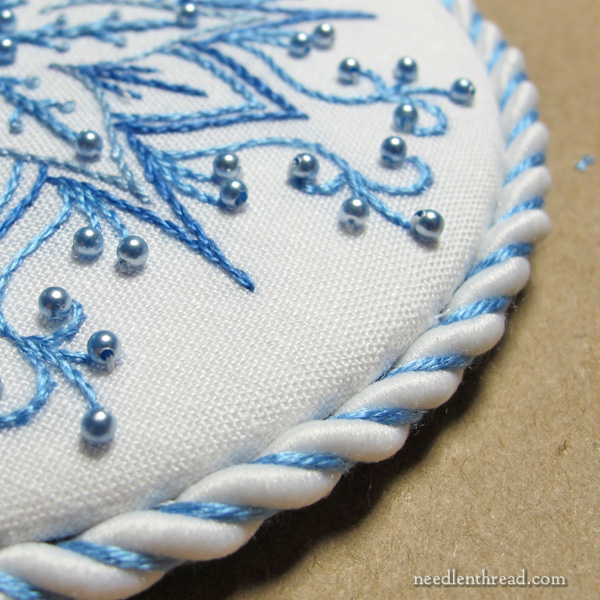
So, trim!
In all things, look to the end.
(There’s nothing quite like starting an article on a Monday morning with such a deep philosophical statement!)
In any case, the statement above – I think Herodotus may have said it first (I could be wrong) – is good advice, and it fits well with needlework.
When you set out on a needlework journey – unless you’re just meandering for the learning experience or the fun of it – it helps to consider where you plan to arrive at the end of the particular journey.
And if you plan to arrive at a finished object like an ornament, it’s a good idea to consider the finish from the very beginning. You want to be able to finish an ornament in a way that “works” with the overall design and execution.
So I put in a collection of trims before I started the ornaments, and as the ornaments began to develop, I kept my eye out and my mind open for trims that I could add to my collection of possibilities.
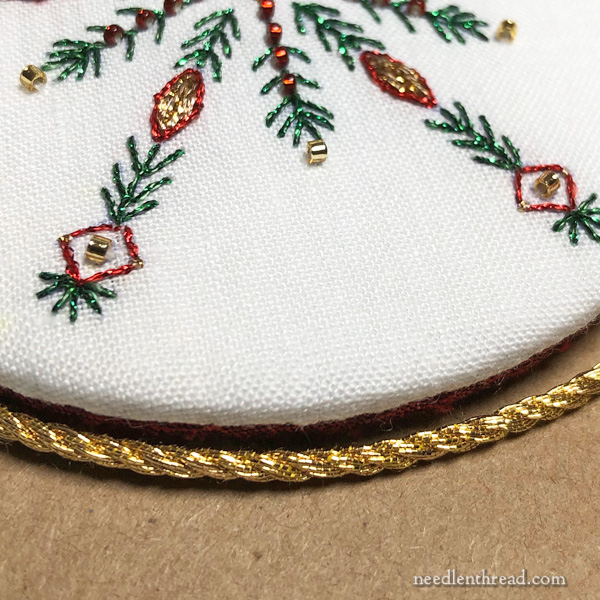
Selecting trims can sometimes be a serendipitous experience.
There you are, short of time, running into a fabric store to pick up, say, some batting. While careening towards the batting section, you pass an aisle of trims and ribbons. Something catches your eye. You come to a screeching halt. “Why, look at that!” you exclaim aloud for all to hear. “What a perfect little trim for my snowflakes! YAY!” and you grab the spool and continue your madcap rush for the batting.
But usually, we have to plan a bit to get trims that will work well.
There are a few points to take into consideration when selecting trims:
1. The size of the thing you’re trimming
2. The shape of the thing you’re trimming
3. The type of finish you’re executing
4. The colors and textures involved, and
5. Exactly how much fiddle work you want to put into the whole finishing experience.
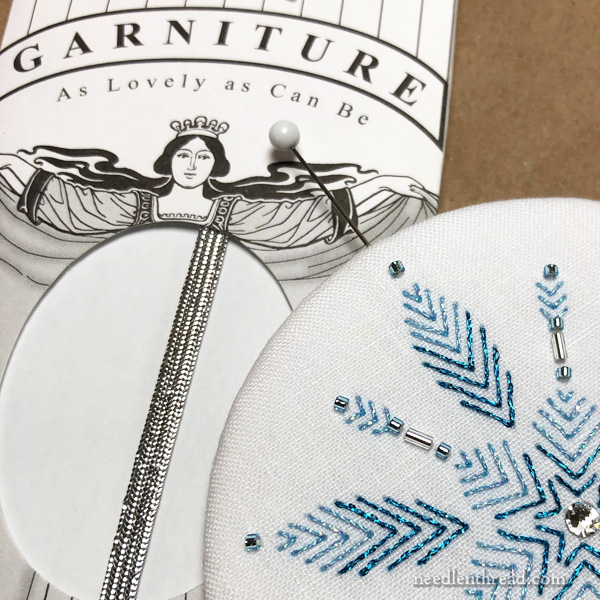
It just so happens that there’s a fantastic line of trims for finely embroidered goods already on the market.
They’re called Garniture, from Access Commodities. You can look at them here on their website, but if you want any of them, you’ll need to special order them through your local needlework shop or your favorite online locally owned shop.
So, for my snowflakes, I already had some of the Garniture twists and trims in mind. They are small enough for ornaments, and many of them were perfectly suited for what I had in mind.
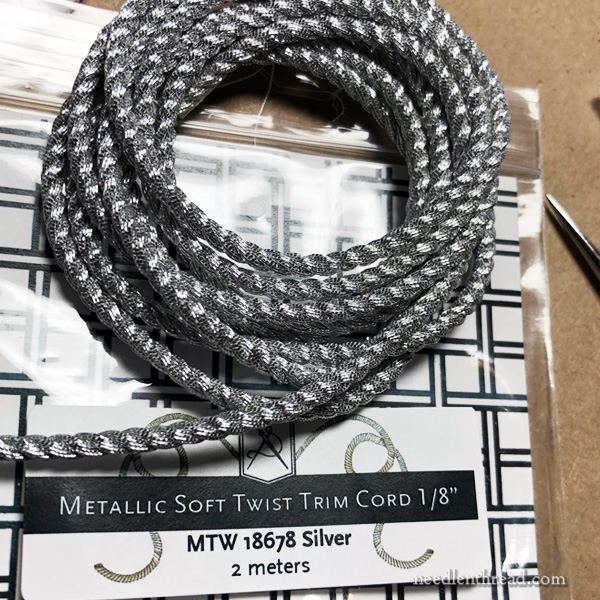
Access Commodities also has a line of soft metallic twists in silvers and golds that are excellent for trimming out ornaments. I wrote about these a while ago here.
Again, these are available through locally owned needlework shops. If they don’t have them in stock, you can ask them to special order them.
The soft metallic twists are beautiful and they are easy to work with. Since my ornaments will all be finished with tabs and twisted trims, it worked out well to have several of the soft metallic twists on hand.
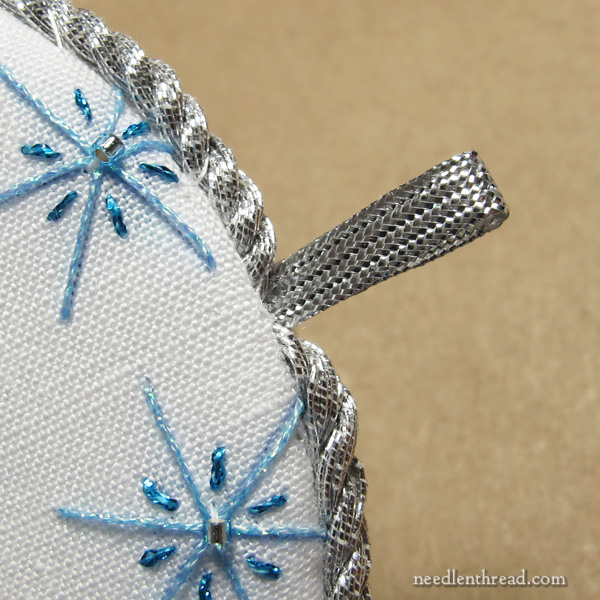
This is what I mean by tabs and twists for finishing my snowflakes. Each flake has a tab or small loop at the top, and then a twisted cord of some sort around the edge.
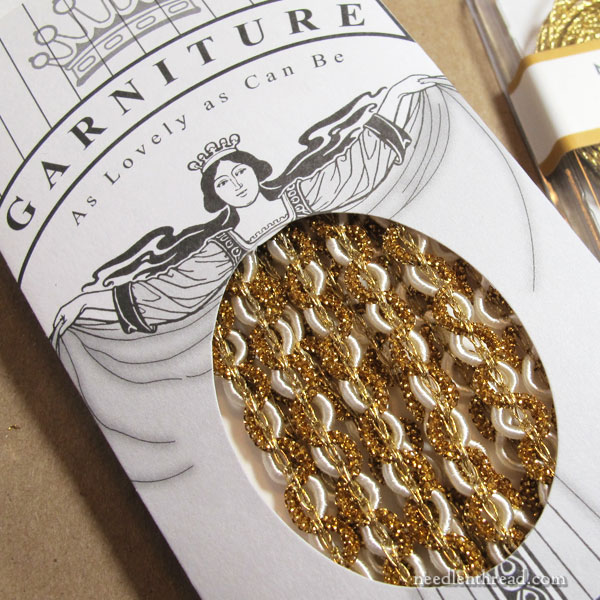
Of course, there are more than just twists for finishing edges. There are fancy braids and squiggles and laces and whatnot, too.
But this is where I took into consideration how much “fiddle time” I wanted to put into the finishing.
Twists are probably the easiest approach to finishing an edge, and for the sake of an instructional e-book – especially for those who have not done much of their own finishing – they’re a good introduction to achieving a professional, neat finish on a project.
Other Sources for Trims
Never underestimate the ribbon aisle at a craft store. You can find myriad twists and trims in there, in both full spools or by-the-yard options. Just be aware that upholstery trims are usually way too large for ornament finishing!
You can also make your own twists out of embroidery thread, ensuring a perfect match to your finished ornament. Here’s a good YouTube video here on twisted your own cord using yarn. The concept is exactly the same for embroidery. You would only need to fold one length of 6-stranded floss in half for the original length of thread for a cord on projects this size.
Or, you can do what I did for the white twist in the first photo of this article – combine the bought twist with the DIY twist. I purchased a white twisted cord and then twisted a length of floss into the purchased cord to achieve just the right color match. Because a twist like this is two-ply, you actually have to twist the matching floss twice, if you want color between each white twist. You can do this with any color of pre-twisted cording.
Dating Ornaments
So, the question about dating ornaments…
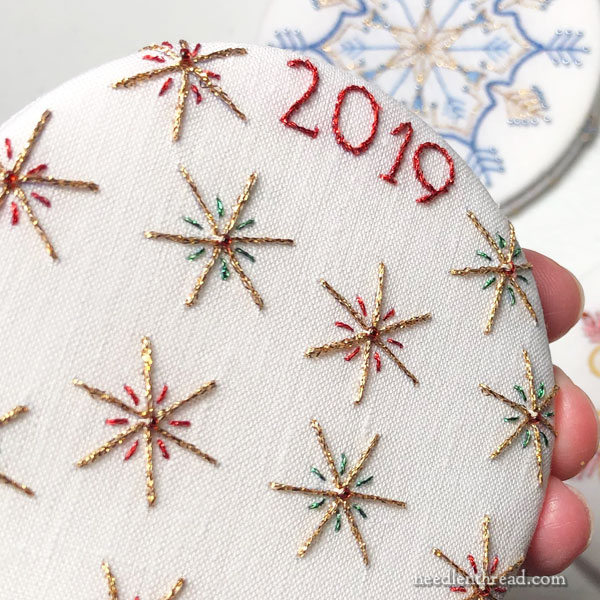
Yes, some of my ornaments are dated. The e-book will feature two possible designs for the backs of the ornaments, with dated and undated versions of those designs.
Some people like to date their ornaments. Some people don’t. Some people like to sign their ornaments; some people don’t.
Especially if I’m giving something as a gift, I will often stitch my initial very subtly somewhere on the back (usually in the same color as the ground fabric). If I’m going to date a Christmas ornament, I date it boldly. Otherwise, I don’t date it.
That’s just my personal preference. Do what you prefer!
I hope this gives you some ideas for finishing your own embroidery projects!
And happy Monday all around!







What circular material did you use under the ornament! I have just finished one of the Patron patterns you shared. Love your work! Missie Krueger
Hi Mary, You do such beautiful embroidery !
Mary those are lovely, beautifully executed and finished. The best advice I ever got was from a teacher who told me that before I start a project, I need to know what it’s going to be. Her name was Rita Buchanan. She was teaching a class on spinning to weave. But her lesson has applied to many things I have tried to accomplish. Now when I find something I want to embroider, I need to know what it’s going to be.
For my ornament smalls, I pick out the backing fabric, the cardboard, the stuffing and I pull out trims along with my threads. I have a lot of threads that are one of. So I look to see if there’s enough to do both the trim AND the project, before I start.
I know, it makes a mess, but when I get it all figured out, I put the whole thing in a project bag and put it in the queue. This way I don’t get to the week before Christmas scrambling to find the piece of green velvet (I know it’s here somewhere) and the green and gold tassels I made.
I have an ornament queue. I was just checking it and I have one I didn’t make last year, and everything is here to make it. Done and dusted!
I love your round ornaments.
Simply stunning!!! Love it all 🙂
If you are making lots of twist trims, especially longer lengths, check out the thrift stores and garage sales for battery operated hair twisters. It will make the task much easier and faster than twisting by hand, and make 3-color twists. Sometimes the power drill with a hook is just a bit of overkill for the job 🙂
Your snowflakes are lovely, Mary!
The finishing trims are beautiful!
When I read this paragraph:
I also received a few questions about dating. Well,
that’s kind of a personal topic – but I’ll answer that
question below, too.
For a few minutes, I thought people had asked you about dating…as in romance.
Whoopsie! I had a good laugh at my confusion.
Mary, thank you for a wonderful snowflake series.
Hi, Beth! Yes, well… I wrote that tongue-in-cheek! LOL!
Hi Mary—thanks for the link to Access Commodities Garnitures! I missed your previous article. May I mention several great ways to make your own trims? Kumihimo, Chinese & other braiding techniques allow an infinite variety of types, colors, textures & sizes to fit any project. Cords work up quickly, especially on a maru dai or Chinese braiding stand. Large threads can be braided easily, however, an inexpensive Kumihimo disc works nicely for small scale cording. Bobbin lace techniques are great for flat tape. Plaits are typically two pair (four bobbins), but three-, four-pair plaits can be made too. Think shoe lace construction. Lucet is another method for cording & of course, there’s always bobbin lace for cloth tape or lacy trim. Some very sweet edgings require only a few bobbins. All these methods allow you to use threads from your project for a perfect match. I hope you & your readers will consider these options if “store bought” trim doesn’t make the grade. You will never regret learning these extra skills to make the most of your embroidery project.
I love kumihimo – I wrote about it previously, when I made cording for a linen pouch. My marudai has not had much use lately, I’m afraid. No time to make braid for these, but perhaps for some future ornaments!
Your work and attention to detail just blow me away. I hadn’t considered ornaments but now I want to do a few as special gifts. Looking forward to the e-book.
Lovely finishing. I do envy your access to the Garniture trims, they look wonderful.
I generally make my own trims. I find Kumihimo braiding a good choice. There are a number of patterns one can make and the weight of the cord is completely up to you. It’s also possible to (almost) invisibly join the ends so that you have a continuous border.
Mary I can’t thank you enough for your newsletters. They are so filled with great information. You take the time to explain your favorite tools & why & where to go to purchase the best for quality & price. Your videos are excellent & a pleasure to watch. Your stitching is fantastic & I love the designs you choose to make.
I hope life is being kind & I so look foward to your next news letter.
Happy Stitching Mary,
Dianne
Hiya apologies for the silly question, but how do you attach the cord neatly? I can see a few tiny stitches on one of the photos but when I have tried to do this the cord ends up flattened or a bit boxy. Is there another article you could direct me to?
I sew the cord on the inside of one side of the ornament first, and it doesn’t have to be neat, because it will be sandwiched between the two sides. Then, I just work around the cord when sewing the edge. So the cord is really secured inside, and not on the edge.